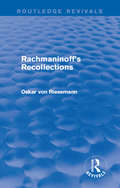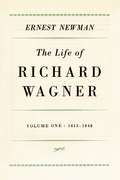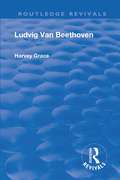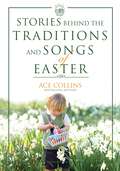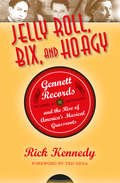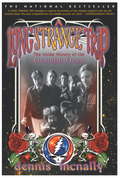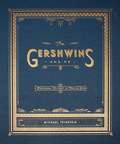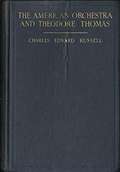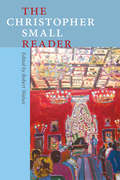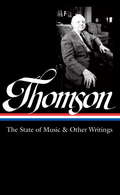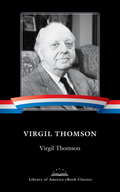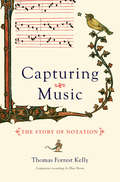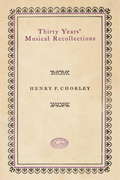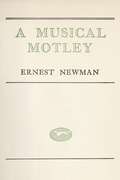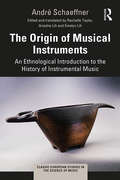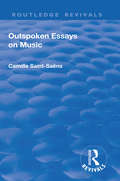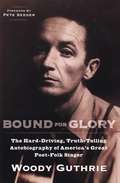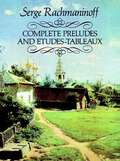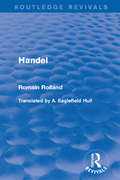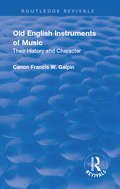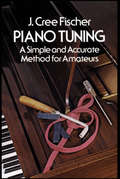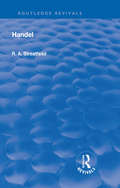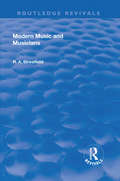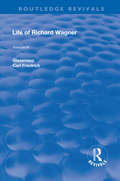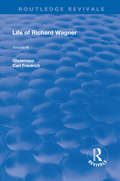- Table View
- List View
Rachmaninoff's Recollections (Routledge Revivals)
by Oskar von RiesemannThis book, first published in 1934, contains the recollections of the varied and coloured life of a great pianist and composer, who is one of the most striking figures of the musical world. Rachmaninoff dictated his memoires to the author of this book, and much of the story is therefore told in the first person. The final chapter is Riesemann’s own contribution. It is an estimate of Rachmaninoff’s qualities as composer; it shows knowledge of all his more important works; and it shows discrimination. The whole book is an authoritative and interesting study of a popular artist.
Life of Richard Wagner, Volume 1: 1813-1848
by Ernest NewmanFrom renowned music critic and musicologist Ernest Newman comes the first of four volumes chronicling the life of legendary German composer Richard Wagner. This first volume takes us through the early years of Richard's life: his birth in Leipzig; his childhood in Dresden and the sparks of his interest in music, opera, and theater; his musical education, including his studies at University of Leipzig; his early career, accompanied by his first compositions and first money troubles; and his six years spent in Dresden, including his involvement in left-wing politics. Originally published between 1933 and 1947, Newman's The Life of Richard Wagner, Volumes I-IV remains a classic work of biography. The culmination of forty years' research on the composer and his works, these books present a detailed portrait of perhaps the most influential, the most controversial and the most frequently reviled composer in the whole history of western music. Newman was aware that no biography can ever claim to be complete or completely accurate: "The biographer can at no stage hope to have reached the final truth. All he can do is to make sure that whatever statement he may make, whatever conclusion he may come to, shall be based on the whole of the evidence available at the time of writing." In this aim he triumphantly succeeds.
Revival: Beethoven (1933) (Routledge Revivals)
by Harvey GraceThe original intention was that this book should be entirely biographical. If it be true, however, that out main interest is (or ought to be) in what a composer did rather than in what he was, the truth applies especially to Beethoven, and above all at the present time. The scheme of the book has therefore been modified so as to include a survey of his work. An attempt to make such survey cover the whole of Beethoven’s output would result in little more than a catalogue, with annotations to brief as to convey hardly anything of the essential quality of the music. It seemed, therefore, that the limited space would be best used, and the needs of the general reader more fully met, by a much less rigid and comprehensive method. My aim has been to indicate some, at least, of the more important characteristics of Beethoven’s works, and to show their influence on his successors.
Stories Behind the Traditions and Songs of Easter
by Ace CollinsStories Behind the Traditions and Songs of Easter reveals the real inspiration behind the customs, symbols, and special music of Easter. Through his gift as a storyteller, award-winning author Ace Collins brings new meaning and depth to the celebration of Easter.
Jelly Roll, Bix, and Hoagy, Revised and Expanded Edition: Gennett Records and the Rise of America's Musical Grassroots
by Rick Lee KennedyIn a piano factory tucked away in Richmond, Indiana, Gennett Records produced thousands of records featuring obscure musicians from hotel orchestras and backwoods fiddlers to the future icons of jazz, blues, country music, and rock 'n' roll. From 1916 to 1934, the studio debuted such stars as Louis Armstrong, King Oliver, Bix Biederbecke, Jelly Roll Morton, Hoagy Carmichael, Blind Lemon Jefferson, Charley Patton, and Gene Autry. While Gennett Records was overshadowed by competitors such as Victor and Columbia, few record companies documented the birth of America's grassroots music as thoroughly as this small-town label. In this newly revised and expanded edition of Jelly Roll, Bix, and Hoagy, Rick Kennedy shares anecdotes from musicians, employees, and family members to trace the colorful history of one of America's most innovative record companies.
A Long Strange Trip: The Inside History of the Grateful Dead
by Dennis McnallyThe complete history of one of the most long-lived and legendary bands in rock history, written by its official historian and publicist--a must-have chronicle for all Dead Heads, and for students of rock and the 1960s' counterculture. From 1965 to 1995, the Grateful Dead flourished as one of the most beloved, unusual, and accomplished musical entities to ever grace American culture. The creative synchronicity among Jerry Garcia, Bob Weir, Phil Lesh, Bill Kreutzmann, Mickey Hart, and Ron "Pigpen" McKernan exploded out of the artistic ferment of the early sixties' roots and folk scene, providing the soundtrack for the Dionysian revels of the counterculture. To those in the know, the Dead was an ongoing tour de force: a band whose constant commitment to exploring new realms lay at the center of a thirty-year journey through an ever-shifting array of musical, cultural, and mental landscapes. Dennis McNally, the band's historian and publicist for more than twenty years, takes readers back through the Dead's history in A Long Strange Trip. In a kaleidoscopic narrative, McNally not only chronicles their experiences in a fascinatingly detailed fashion, but veers off into side trips on the band's intricate stage setup, the magic of the Grateful Dead concert experience, or metaphysical musings excerpted from a conversation among band members. He brings to vivid life the Dead's early days in late-sixties San Francisco--an era of astounding creativity and change that reverberates to this day. Here we see the group at its most raw and powerful, playing as the house band at Ken Kesey's acid tests, mingling with such legendary psychonauts as Neal Cassady and Owsley "Bear" Stanley, and performing the alchemical experiments, both live and in the studio, that produced some of their most searing and evocative music. But McNally carries the Dead's saga through the seventies and into the more recent years of constant touring and incessant musical exploration, which have cemented a unique bond between performers and audience, and created the business enterprise that is much more a family than a corporation. Written with the same zeal and spirit that the Grateful Dead brought to its music for more than thirty years, the book takes readers on a personal tour through the band's inner circle, highlighting its frenetic and very human faces. A Long Strange Trip is not only a wide-ranging cultural history, it is a definitive musical biography.
The Gershwins and Me: A Personal History in Twelve Songs
by Michael FeinsteinFrom celebrated entertainer Michael Feinstein comes a beautifully illustrated account of the lives and legacies of the Gershwins--told through stories of twelve of their greatest songs.The "Ambassador of the Great American Songbook" Michael Feinstein was just twenty years old when he got the chance of a lifetime: a job with his hero, Ira Gershwin. During their six-year partnership, the two became close friends. Feinstein blossomed under Gershwin's mentorship and Gershwin was reinvigorated by the younger man's zeal for his and his brother George's legacy. Now, in The Gershwins and Me, the only book of its kind, Michael Feinstein shares unforgettable stories and reminiscences from the music that defined American popular song, along with rare Gershwin memorabilia he's collected through the years. From "Strike Up the Band" to "Love Is Here to Stay," each of the twelve chapters highlights one of the Gershwins' classic songs, exploring the brothers' lives, illuminating what the music meant to them, and telling the stories of how their iconic tunes came to life. Throughout the star-studded narrative, Feinstein unfolds the moving chronicle of his own life with the Gershwins, describing his vision for their enduring presence today. No other writer could give us such an authoritative inside perspective on these titans of American culture. A timeless classic and the definitive account of the Gershwins and their legacy, The Gershwins and Me will having you humming with every turn of the page.
The American Orchestra and Theodore Thomas
by Charles Edward RussellThe history of the American orchestra.<P><P> Pulitzer Prize Winner
The Christopher Small Reader (Music/culture Ser.)
by Christopher Small Robert WalserThe Christopher Small Reader is the fourth and final book in Christopher Small's legacy as a composer, pianist, teacher, friend, provocateur, and influential outsider in classical music studies. It is at once a compendium of, a complement to, and an important addition to Small's prior books: Musicking; Music, Society, Education; and Music of the Common Tongue. The Christopher Small Reader brings previously published work, some of it available in disparate locations, together with key excerpts from his three books, and other writings that remained unpublished at his passing in 2011, making available ideas that were not included in the earlier books and presenting an overview of his thought over the course of his life. The collection is a fitting capstone, providing rich insights into Small's understanding of musicking as a crucial way of relating to the world.
Virgil Thomson: Library of America #277
by Tim Page Virgil ThomsonAn unprecedented collection of polemical and autobiographical writings by America's greatest composer-critic. Following on the critically acclaimed 2014 edition of Virgil Thomson's collected newspaper music criticism, The Library of America and Pulitzer Prize-winning music critic Tim Page now present Thomson's other literary and critical works, a body of writing that constitutes America's musical declaration of independence from the European past. This volume opens with The State of Music (1939), the book that made Thomson's name as a critic and won him his 14-year stint at the New York Herald Tribune. This no-holds-barred polemic, here presented in its revised edition of 1962, discusses the commissions, jobs, and other opportunities available to the American composer, a worker in a world of performance and broadcast institutions that, today as much as in Thomson's time, are dominated by tin-eared, non-musical patrons of the arts who are shocked by the new and suspicious of native talent. Thomson's autobiography, Virgil Thomson (1966), is more than just the story of the struggle of one such American composer, it is an intellectual, aesthetic, and personal chronicle of the twentieth century, from World War I-era Kansas City to Harvard in the age of straw boaters, from Paris in the Twenties and Thirties to Manhattan in the Forties and after. A classic American memoir, it is marked by a buoyant wit, a true gift for verbal portrait-making, and a cast of characters including Aaron Copland, Gertrude Stein, James Joyce, Paul Bowles, John Houseman, and Orson Welles. American Music Since 1910 (1971) is a series of incisive essays on the lives and works of Ives, Ruggles, Varèse, Copland, Cage, and others who helped define a national musical idiom. Music with Words (1989), Thomson's final book, is a distillation of a subject he knew better than perhaps any other American composer: how to set English--especially American English--to music, in opera and art song. The volume is rounded out by a judicious selection of Thomson's magazine journalism from 1957 to 1984--thirty-seven pieces, most of them previously uncollected, including many long-form review-essays written for The New York Review of Books.From the Hardcover edition.
Virgil Thomson: A Library of America E-Book Classic
by Virgil ThomsonVirgil Thomson was a gifted composer and one of the nation's foremost cultural critics. The best-selling autobiography Virgil Thomson (1966) is his gossipy telling of his own extraordinary progress from unteachable smart aleck to revered elder statesman. It recounts his artistically precocious Kansas City boyhood, demanding Harvard education, apprenticeship in Paris between the wars, and hard-won musical and literary maturity in New York. As narrator and protagonist, Thomson fascinates not only with his own story but also with those of his associates, collaborators, friends, and rivals, among them Gertrude Stein, Alice B. Toklas, Ezra Pound, James Joyce, Nadia Boulanger, George Antheil, Pablo Picasso, Jean Cocteau, Max Jacob, Pare Lorentz, John Houseman, and Orson Welles. Virgil Thomson is an authentic work of Americana and a first-rate, first-person history of the rise of modernism.Complete with 32 pages of photographs.
Capturing Music: The Story Of Notation
by Thomas Forrest KellyAn entertaining history of how musicians learned to record music for all time, filled with art that sings. In today’s digital landscape, we have the luxury of experiencing music anytime, anywhere. But before this instant accessibility and dizzying array of formats—before CDs, the eight-track tape, the radio, and the turntable—there was only one recording technology: music notation. It allowed singers and soloists to travel across great distances and perform their work with stunning fidelity, a feat that we now very much take for granted. Thomas Forrest Kelly transports us to the lively and complex world of monks and monasteries, of a dove singing holy chants into the ear of a saint, and of bustling activity in the Cathedral of Notre Dame—an era when the only way to share even the simplest song was to learn it by rote, church to church and person to person. With clarity and a sense of wonder, Kelly tells a story that spans five hundred years, leading us on a journey through medieval Europe and showing how we learned to keep track of rhythm, melody, and precise pitch with a degree of accuracy previously unimagined. Kelly reveals the technological advances that led us to the system of notation we use today, placing each step of its evolution in its cultural and intellectual context. Companion recordings by the renowned Blue Heron ensemble are paired with vibrant illuminated manuscripts, bringing the art to life and allowing readers to experience something of the marvel that medieval writers must have felt when they figured out how to capture music for all time.
A Musical Motley
by Ernest NewmanThis is a reproduction of a book published before 1923. This book may have occasional imperfections such as missing or blurred pages, poor pictures, errant marks, etc. that were either part of the original artifact, or were introduced by the scanning process. We believe this work is culturally important, and despite the imperfections, have elected to bring it back into print as part of our continuing commitment to the preservation of printed works worldwide. We appreciate your understanding of the imperfections in the preservation process, and hope you enjoy this valuable book.
The Origin of Musical Instruments: An Ethnological Introduction to the History of Instrumental Music (Classic European Studies in the Science of Music)
by André SchaeffnerThe work of French musicologist, ethnologist and critic Andre Schaeffner (1895– 1980) grew out of his first organological studies of the history of Western classical instruments in the late 1920s and encapsulated in his wide-ranging Origine des instruments de musique, which captures his studies in Paris between 1931 and 1936. Almost 80 years after its first publication, the scientific relevance and influence of Schaeffner’s primary hypothesis—that the origins of music can be traced to the human body through gesture, dance and the movements in the use of musical instruments and their ancestor tools—remains pertinent in fields which have returned to informed speculative and empirical research on the origins of music. This first English edition is accompanied by editorial footnotes and introductory texts, and the influence of Schaeffner’s thought on several generations of musicologists makes his work an essential piece of reading for ethnomusicologists, music psychologists, organologists and musicologists interested in the history of their field.
Revival: Outspoken Essays on Music (Routledge Revivals)
by Camille Saint-SaensA series of essays on reactions and emotional responses to music.
Bound for Glory
by Woody GuthrieBound for Glory is the autobiography of Woody Guthrie, the founder of modern American folk music. It is a funny, cynical, earthy and tragic account of his life in an Oklahoma oil-boom town, of the Depression that followed,and of his subsequent travels in, on,and under trains, in stolen cars and on his feet, round an America going rotten from the top downwards
Complete Preludes and Etudes-Tableaux (Dover Music For Piano Ser.)
by Serge RachmaninoffThe 24 preludes and 17 etudes-tableaux of Serge Rachmaninoff include what are possibly his finest compositions for solo piano. Each of these masterly works is included in this complete collection, reproduced from recent, authoritative Russian editions. They include: Prelude, Op. 3, No. 2; Ten Preludes, Op. 23; Thirteen Preludes, Op. 32; Eight Etudes-tableaux, Op. 33; Nine Etudes-tableaux, Op. 39. Among these are the enormously popular C-sharp minor prelude, Op. 3, No. 2; the G-minor prelude, Op. 23, No. 5; and the B-minor prelude, Op. 32, No. 10 — classics that have made Rachmaninoff one of the most performed and recorded modern composers.Each of these works reflects Rachmaninoff's emotional intensity, his thrilling gifts as a melodist and his ability to crystallize perfectly a particular mood or sentiment. In their sonorous textures and rich embellishment, they reflect as well his sovereign command of keyboard technique and his spectacular gifts as a pianist (he was one of the very greatest pianists of the 20th century). This beautifully produced yet inexpensive edition will provide both amateur and professional pianists a lifetime of study and enjoyment, and will afford music lovers as well the deep pleasures of following, music in hand, live and recorded performances of these keyboard masterpieces.
Handel (Routledge Revivals)
by Romain RollandRolland’s biography attempts to provide an overview of Handel’s life and works from his early lessons in music to the classical context in which he is commonly placed. Originally published in English in 1916, Hull’s translation gives an insight into biographical facts and the musical pieces composed by Handel including his operas, oratorios and chamber music. This title will be of interest to students of music and musical history.
Revival: Their History and Character (Routledge Revivals)
by Francis W. GalphinThe study of musical instruments now no longer with us is necessary, not only for the musician and composer, but for the man of letters, the artist, and the chronicler of our national life; for many allusions to customs of bygone times cannot otherwise be understood, and we should be spared such a trying ordeal as we were recently subjected to by one of our leading illustrated papers, which introduced into a thirteenth century scene a twentieth century mandoline with an up to date mechanism.
Piano Tuning: A Simple and Accurate Method for Amateurs (Dover Books On Music: Piano)
by J. Cree FischerIf you have a note that has dropped in pitch, do you have to call in the tuner? A stuck key? Sympathetic rattle? Missing bridles? A broken hammer shank? An unglued ivory? The answer, in each case, is no: you can make all of these repairs yourself!This is the clearest and most complete book available for beginning tuners and amateur pianists. It explains all the basic processes practically and with model clarity. A non-musician can use this book without too much difficulty.You will learn how upright, grand, and square actions work, and how to take care of the smallest repairs — repairing stuck keys, poorly adjusted bottoms and capstans, crowded back checks, felts and leather on the hammers, hammer stems; softening damper and hammer felts; installing new bridles; eliminating "sympathetic rattle"; all with a minimum of tools and training.You will learn a professional method of tuning based on slightly flattened fifths, where only the octave and the upward fifth intervals are used. This is one of the easiest systems to learn, one capable of a great deal of control, and one perfectly suited to adjusting one or two keys. It is a tested method especially right for amateurs working without a teacher, and a method that trains the ear for other recommended systems. The author also explains "beats," the theory of the tempered scale, and useful experiments you can make with harmonic phenomena.If you want to experiment with tuning a piano, there is no better book to start with. It will help performers and teachers make occasional repairs and learn the structure and scale of the piano. Those who want to know how pianos work will find this book both clear and useful.
Revival: Handel (Routledge Revivals)
by Richard Alexander StreatfieldIt is the inner meaning of Handel’s music, and its power of searching the profoundest recesses of the soul, that in the following pages I have endeavoured, so far as I am able, to elucidate. Its merely technical qualities have already been discussed enough and to spare. Books on Handel written by musicians already abound, but musicians as a rule take more interest in the means by which an end is attained than the end itself. They tell us a great deal about the methods by which a composer expresses himself, but very little about what he actually has to express. I have tried, how feebly and with what little success no one knows better than myself, to find the man Handel in his music, to trace his character, his view of life, his thoughts, feelings, and aspirations, as they are set forth in his works.
Revival: Modern Music and Musicians (Routledge Revivals)
by Richard Alexander StreatfieldA plethora of biographical accounts of some of the contemporary composers and musicians at the turn of the twentieth century.
Revival: Art and Politics (Routledge Revivals)
by Carl Francis GlasenappFourth volume of Carl Francis Glasenapp's Life of Richard Wagner.
Revival: The Theatre (Routledge Revivals)
by Carl Francis GlasenappThird volume of Carl Francis Glasenapp's Life of Richard Wagner.
